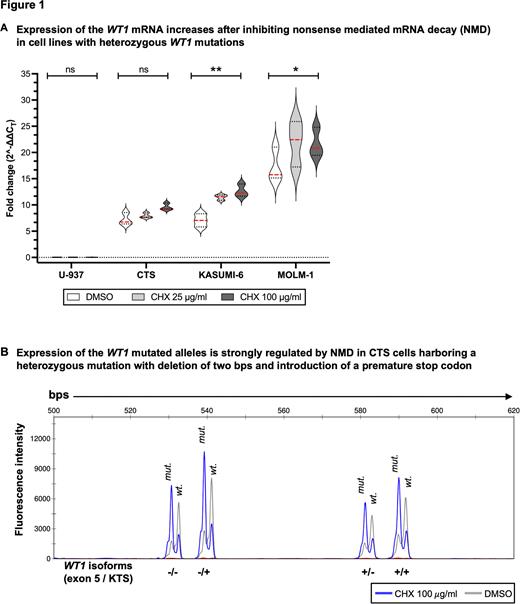Abstract
Background
The Wilms Tumor 1 (WT1) gene is highly expressed in almost all types of malignancies including acute myeloid leukemia (AML). It is also mutated in up to 20% of AML blasts in pediatric and adult patients. Both, the increased expression and also the presence of mutations are correlated negatively with chance of survival in different AML patient cohorts. We and others have previously showed devastating survival outcomes in children with AML blasts harboring WT1 mutations in combination FLT3-ITD and NUP98-NSD1 (Niktoreh et al., 2019). As WT1 can act as both, oncogene and tumor suppressor gene, this study was designed to analyze the WT1 genomic locus mutations in acute leukemia blasts.
Methods and Results
Screening for WT1 sequence alterations. Using the TruSight Myeloid Sequencing PanelTM (Illumina), we initially screened 35 leukemia and lymphoma cell lines for genomic alterations in 54 genes. This panel allowed us to detect even low variant-allele-frequency (VAF) alterations in the mutational hotspots of WT1, exons 7 and 9. In addition to a known WT1 mutation in CTS cells (AML M1), we discovered novel alterations in three other malignant cell lines. KASUMI-6 cells (AML M2) harbored the identical mutation as CTS cells, a 2-bp deletion in WT1 exon 7 leading to frameshift with a premature termination codon (c.1202_1203delGA, p.Arg401IlefsTer3). The U937 histiocytic lymphoma cells carried the known TP53 mutation and also an unknown heterozygous nonsense mutation in WT1 exon 7, changing the arginine 369 into a premature stop codon (c.1105C>T, p.Arg369Ter). Interestingly, MOLM-1 cells (CML in blast crisis) harbored a p.Arg462Gln alteration. Next, we performed Sanger sequencing for the complete coding region of WT1, including the upstream promoter as well as the 5'UTR and 3'UTR regions, all 10 exons and the adjacent 150 bp intronic sequences at the exon-intron boundaries. Sanger sequencing confirmed the mutations discovered via NGS and revealed single bp alterations in the WT1 promoter region of CTS cells and in the 5'UTR of K-562 cells. We also detected a recurring variation in intron 3 of WT1 (c.872+16G>A) in the cell lines K-562, NB-4, M07e and UOC-M1; the functional implications of the alterations are yet to be determined.
Functional impact of WT1 mutations. To understand the potential impact of the WT1 sequence alterations, we studied the WT1 mRNA expression in these cells in the presence of cycloheximide (CHX), an inhibitor of the nonsense-mediated mRNA decay (NMD) machinery. As shown in figure 1A, U937 cells were used as negative control cells, as they are known to have no expression of the WT1 mRNA. Despite the presence of mutations in CTS, KASUMI-6 and MOLM-1 cells, all three cell lines expressed elevated levels of WT1, well within the range of 30 other malignant cell lines without any alterations/mutations in the WT1 locus (data not shown). To differentiate the WT1 expression between the mutated and the wildtype allele, we performed a fragment length analysis on a capillary electrophoresis system using the complimentary DNA of CHX-treated cell lines. For these analyses, we employed a multiplex PCR strategy using ABL1 as housekeeping gene and a primer pair binding in exons 4 and 10 of WT1. As delineated in figure 1B, the mutated alleles in CTS and KASUMI-6 cells, which are 2-bps shorter, could be easily separated from the wildtypes (data for KASUMI-6 not shown). Additionally, since our primer pair also amplified the alternatively spliced exon 5 and the alternative splice donor at the end of exon 9, leading to inclusion or exclusion of three amino acids (KTS), we were able to separately analyze the four major WT1 isoforms from both alleles. As shown in figure 1B, the expression levels of the WT1 mutated alleles of CHX-treated cells increased 2- to 3-fold compared to DMSO-treated cells in CTS and 3- to 4-fold in KASUMI-6 (data not shown).
Conclusion
Careful analyses of the WT1 genomic locus in 35 malignant hematological cell lines revealed previously unknown heterozygous loss-of-function WT1 mutations in KASUMI-6, MOLM-1 and U-937 cells. mRNA expression analysis demonstrated that these mutations are strongly regulated by NMD machinery, leading to (almost) complete downregulation of the mutated WT1 allele. These results strongly question any direct effect of WT1 mutations in the leukemic blasts and therefore cannot explain the role of mutations in WT1 as a prognostic factor in AML.
Disclosures
Reinhardt:BMS: Membership on an entity's Board of Directors or advisory committees; Novartis: Membership on an entity's Board of Directors or advisory committees, Research Funding; Cerus: Membership on an entity's Board of Directors or advisory committees; Medac: Membership on an entity's Board of Directors or advisory committees; EUSA Pharma: Membership on an entity's Board of Directors or advisory committees; BlueBird Bio: Research Funding.
Author notes
Asterisk with author names denotes non-ASH members.


This feature is available to Subscribers Only
Sign In or Create an Account Close Modal